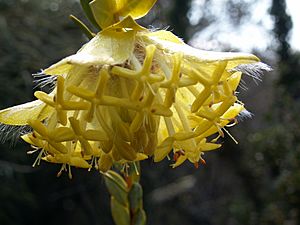Scented banjine facts for kids
Quick facts for kids Scented banjine |
|
|---|---|
 |
|
| Pimelea suaveolens subsp. suaveolens near Albany | |
| Scientific classification | |
| Genus: |
Pimelea
|
| Species: |
suaveolens
|
| Synonyms | |
|
Calyptrostegia suaveolens (Meisn.) Endl. |
|
The scented banjine, also called the silky-yellow banjine, is a unique shrub. Its scientific name is Pimelea suaveolens. This plant has tall, thin stems and beautiful yellow flowers. These flowers often look a bit hairy. You can find the scented banjine growing in forest areas. It lives in the southwestern part of Western Australia. Its range goes from New Norcia down to Albany.
Contents
What Does the Scented Banjine Look Like?
The scented banjine is a tall, slender shrub. It often has many stems growing from its base. This plant can grow to be about 0.25 to 1.2 meters (10 inches to 4 feet) tall. Its stems and leaves are smooth, meaning they have no hairs.
The leaves grow in pairs on opposite sides of the stem. They are shaped like swords and are about 10 to 30 millimeters (0.4 to 1.2 inches) long. The flowers grow in clusters called inflorescences. These clusters are quite large, about 30 to 40 millimeters (1.2 to 1.6 inches) across.
Each cluster has many pale to deep yellow flowers. These flowers are surrounded by special, hairy, petal-like leaves called bracts. The flower clusters hang down from the branches. You can usually see the scented banjine flowering from June to October.
How Scientists Named the Scented Banjine
The scientific name for the scented banjine is Pimelea suaveolens. Scientists give plants special names to help identify them. This plant was first officially described in 1845. A botanist named Carl Meissner gave it its name. He published his description in a book called Plantae Preissianae. The plant he studied was collected by James Drummond in 1839 near Greenmount.
The second part of the plant's name, suaveolens, is a Latin word. It means "sweet-smelling." This tells us that the plant has a pleasant scent.
Later, in 1988, another botanist named Barbara Lynette Rye studied the scented banjine more closely. She found that there are two different types, or subspecies, of P. suaveolens. These two subspecies are:
- Pimelea suaveolens subsp. flava: This type has green leaves.
- Pimelea suaveolens subsp. suaveolens: This type has glaucous leaves, which means they have a dull, bluish-green color.
Where Does the Scented Banjine Grow?
The scented banjine likes to grow in certain types of soil. You can find it in sand, sandy clay, gravel, and a reddish soil called laterite. It grows in various landscapes like rolling plains, flat areas, ridges, and even along roadsides.
This plant is found in a wide area of Western Australia. Its range stretches between New Norcia and Albany. It grows in several different natural regions. These include the Coolgardie, Avon Wheatbelt, Esperance Plains, Geraldton Sandplains, Mallee, Swan Coastal Plain, Jarrah Forest, and Warren areas.
Is the Scented Banjine Protected?
The Western Australian Government's Department of Parks and Wildlife keeps track of plants. They have classified Pimelea suaveolens as "not threatened." This means that, for now, there are enough of these plants in the wild, and they are not in danger of disappearing.
Growing Scented Banjine in Gardens
It is not too hard to start new scented banjine plants from cuttings. Cuttings are small pieces of the plant that can grow into a new plant. However, it can be tricky to keep these plants alive and healthy in a garden. If you want to try growing them, it's important to make sure the soil drains water well. The plant also prefers to grow in partial shade, not in full sunlight.

